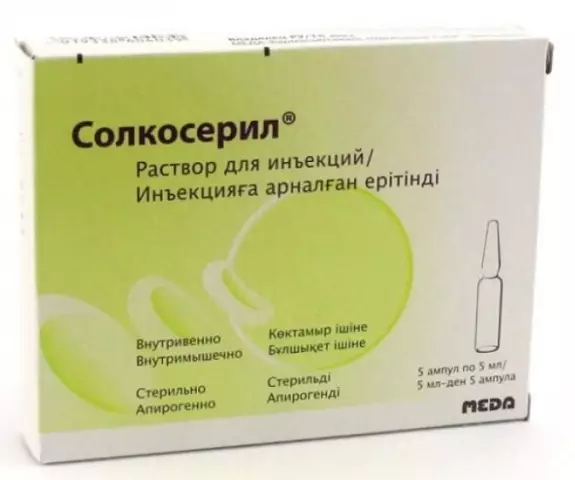- Author Rachel Wainwright [email protected].
- Public 2023-12-15 07:39.
- Last modified 2025-11-02 20:14.
Effient
Effient: instructions for use and reviews
- 1. Release form and composition
- 2. Pharmacological properties
- 3. Indications for use
- 4. Contraindications
- 5. Method of application and dosage
- 6. Side effects
- 7. Overdose
- 8. Special instructions
- 9. Application during pregnancy and lactation
- 10. Use in childhood
- 11. In case of impaired renal function
- 12. For violations of liver function
- 13. Use in the elderly
- 14. Drug interactions
- 15. Analogs
- 16. Terms and conditions of storage
- 17. Terms of dispensing from pharmacies
- 18. Reviews
- 19. Price in pharmacies
Latin name: Effient
ATX code: B01AC22
Active ingredient: prasugrel (prasugrel)
Manufacturer: Eli Lilly & Company (USA)
Description and photo update: 2018-27-11
Prices in pharmacies: from 3779 rubles.
Buy

Effient is an antiplatelet drug.
Release form and composition
The effient is available in the form of film-coated tablets: oblong, yellow or beige, engraved on each side: on one side the inscription "4760" (yellow tablets) or "4759" (beige tablets), on the other - " 5 MG "(yellow tablets) or" 10 MG "(beige tablets) (14 pcs. In blisters, in a cardboard box 2 blisters and instructions for use of Effient).
1 tablet contains:
- active substance: prasugrel hydrochloride - 5.49 mg or 10.98 mg, which is equivalent to 5 mg or 10 mg of prasugrel (base);
- auxiliary components: hypromellose, croscarmellose sodium, microcrystalline cellulose, mannitol, magnesium stearate;
- composition of the shell yellow: opadry II yellow (hypromellose, lactose monohydrate, titanium dioxide, iron dye yellow oxide, triacetin), talc;
- the composition of the shell beige: opadry II beige (triacetin, lactose monohydrate, titanium dioxide, iron dye yellow oxide, hypromellose, iron dye red oxide), talc.
Pharmacological properties
Pharmacodynamics
Effient is an antiplatelet drug with the active ingredient prasugrel. It is an antagonist of the P2Y12 class of receptors for adenosine diphosphate, which causes its inhibition of platelet activation and aggregation. Inhibition of platelet function, which is involved in the development of atherosclerotic complications, helps to reduce the risk of cardiovascular complications (including myocardial infarction, stroke, death from a cardiovascular cause).
After taking a loading dose (60 mg) of prasugrel after 1 hour, inhibition of aggregation of at least 50% of platelets is achieved. The subsequent use of a maintenance dose (10 mg) for 3-5 days provides suppression of aggregation of about 70% of platelets and an equilibrium state.
When Effient is canceled, platelet aggregation gradually (after taking a loading dose - after 7-9 days, a maintenance dose in an equilibrium state - 5 days) returns to its original values.
After previous therapy with clopidogrel (75 mg per day), switching to prasugrel treatment does not cause significant changes in platelet aggregation inhibition.
When comparing prasugrel and clopidogrel, an analysis of the results of a clinical study on the efficacy and safety of their use in combination therapy with acetylsalicylic acid and other drugs showed a statistical superiority of prasugrel in patients with acute coronary syndrome (ACS) at risk of developing unstable angina pectoris or myocardial infarction without segment elevation ST or myocardial infarction with ST segment elevation during percutaneous coronary intervention. In this case, the criterion of effectiveness was the period before death, the first case of non-fatal heart attack or stroke from a cardiovascular cause. The efient has been shown to be more effective in reducing the incidence of the primary combined endpoint and the incidence of secondary endpoints, including stent thrombosis. The benefit of prasugrel was noted throughout the study period.
The superior effect is accompanied by an increase in the frequency of major bleeding (any intracranial hemorrhage or bleeding with clinical manifestations accompanied by a decrease in hemoglobin more than 5 g / dl).
The therapeutic effect of prasugrel is not affected by age, sex, body weight, ethnicity, concomitant therapy [including bivalirudin, heparin, intravenous (iv) administration of platelet glycoprotein IIb / IIIa receptor blockers, hypolipidemic agents, beta-blockers, angiotensin converting enzyme inhibitors (ACE), acetylsalicylic acid at a dose of 75 to 325 mg once a day].
The main advantage is a significant decrease in the incidence of nonfatal myocardial infarction, in diabetes mellitus - a decrease in the incidence of primary and secondary combined endpoints. Patients aged 75 and over have less pronounced benefits of prasugrel than patients younger than 75 years of age.
In all patients with acute coronary syndrome, a comparative analysis showed a significant advantage of prasugrel over clopidogrel in terms of the incidence of detected or possible stent thrombosis, death from a cardiovascular cause, nonfatal myocardial infarction, nonfatal stroke, readmission due to coronary ischemic events or emergency revascularization target vessel within 30 days.
In terms of the incidence of deaths from all causes in patients with ACS, there was no significant difference between prasugrel and clopidogrel.
With prasugrel, there was a 50% reduction in thrombosis of metal stents, both with and without drug eluting, over a long (over a year) follow-up period.
Pharmacokinetics
The pharmacokinetic parameters of prasugrel in healthy volunteers and in patients with a stable course of atherosclerotic process or undergoing percutaneous coronary intervention are similar.
Prasugrel is a prodrug; after oral administration, it is rapidly absorbed and metabolized to active and inactive metabolites.
AUC (total drug concentration) is characterized by low and medium variability in individual patients (19%) and within the population (27%).
The maximum concentration (C max) of the active metabolite in the blood serum is reached after about 0.5 hours. The AUC of the active metabolite is in direct proportion to the therapeutic dose of the drug.
The simultaneous intake of fatty and high-calorie foods does not affect the AUC of the active metabolite, but decreases C max by 49%, increasing the period of reaching it up to 1.5 hours. Taking a loading dose (60 mg) on an empty stomach can provide a faster onset of Effect.
The binding of the active metabolite to serum albumin is 98%.
After oral administration, prasugrel is not detected in plasma, since it is immediately hydrolyzed into thiolactone in the intestine. Under the influence of cytochrome P 450 isoenzymes (mainly CYP3A4, CYP2B6 and to a lesser extent CYP2C9 and CYP2C19), thiolactone is converted into an active metabolite. By S-methylation or conjugation with cysteine, the active metabolite is biotransformed into two inactive metabolites.
On the pharmacokinetic parameters of prasugrel and the suppression of platelet aggregation, genetic variations of the isoenzymes CYP2B6, CYP2C9, CYP3A5 or CYP2C19 have no effect.
Excretion of prasugrel in the form of inactive metabolites is carried out through the kidneys (68%) and intestines (approximately 27%).
T 1/2 (half-life) of the active metabolite averages 7.4 hours.
The age of the patient does not affect the pharmacokinetics of prasugrel or inhibition of platelet aggregation.
The AUC of the active metabolite is 19% higher in patients 75 years of age and older, compared with patients younger than 75 years old. In addition, patients 75 years of age and older are predisposed to a higher incidence of bleeding.
It should be borne in mind that with a patient's body weight of less than 60 kg, the AUC of the active metabolite is 30-40% higher than with a weight of 60 kg or more.
No dose adjustment of Effient is required for ethnicity.
In renal failure, including end-stage renal failure, dose adjustment is not required. Despite the decrease in C max and AUC of the active metabolite in patients with end-stage renal failure by 51% and 42%, respectively, the inhibition of platelet aggregation caused by prasugrel is comparable for patients requiring hemodialysis and healthy volunteers.
With mild to moderate (Child-Pugh grades A and B) hepatic impairment, dose adjustment is not required.
Due to the lack of information on the pharmacokinetics and pharmacodynamics of prasugrel in severe (class C on the Child - Pugh scale) liver failure, the use of Effient for the treatment of this category of patients is contraindicated.
The pharmacokinetics and pharmacodynamics of prasugrel in children and adolescents have not been studied, therefore, its use should not be prescribed to patients under 18 years of age.
Indications for use
The use of Effient is indicated for the prevention of thrombotic complications in acute coronary syndrome in patients with myocardial infarction without ST-segment elevation or unstable angina pectoris undergoing percutaneous coronary intervention, and with myocardial infarction with ST-segment elevation during primary or delayed percutaneous coronary intervention.
In addition, the drug is prescribed for acute coronary syndrome to prevent stent thrombosis.
Contraindications
- peptic ulcer, other pathological conditions with an increased risk of bleeding;
- history of stroke or transient ischemic attack;
- severe liver failure (class C on the Child - Pugh scale);
- lactose intolerance, lactase deficiency, glucose-galactose malabsorption syndrome;
- prospective urgent coronary artery bypass grafting (high risk of postoperative bleeding);
- breast-feeding;
- age up to 18 years;
- established hypersensitivity to the components of the drug.
Due to the high risk of bleeding, Effient should be prescribed with caution: patients aged 75 years or older, weighing less than 60 kg, during pregnancy, with a predisposition to bleeding (including recent trauma or surgery, recent or repeated gastrointestinal bleeding, period of exacerbation of gastric or duodenal ulcers), with moderate hepatic failure, renal failure, history of thrombotic thrombocytopenic purpura, history of angioedema, hypersensitivity reactions against the background of the use of thienopyridines in history, anti-inflammatory drugs, concomitant anti-inflammatory drugs, anti-inflammatory drugs), fibrinolytics and / or other drugs that increase the risk of bleeding.
In addition, it is necessary to stop taking prasugrel 7 days before the planned operation if the antiplatelet effect is undesirable.
Effient, instructions for use: method and dosage
The tablets are taken orally, swallowing whole (without violating the integrity of the film shell), regardless of the meal.
The use of the drug should be accompanied by the intake of acetylsalicylic acid in a daily dose of 75-325 mg.
Recommended dosage: initial (loading) dose - 60 mg once, then 10 mg once a day as a maintenance dose.
Patients with non-ST-elevation myocardial infarction or unstable angina pectoris who are scheduled for coronary angiography within 48 hours of hospitalization should take the loading dose only during percutaneous coronary intervention.
The duration of the course of therapy is up to 365 days.
The recommended dosage for patients with a body weight of less than 60 kg and aged 75 and older: loading dose - 60 mg once, maintenance dose - 5 mg daily.
The use of Effient in patients aged 75 and over is usually not recommended. The drug in this category of patients should be prescribed after a careful individual assessment of the benefit-risk ratio of therapy.
No dose adjustment is required for mild to moderate hepatic impairment (Child-Pugh grades A or B) and renal impairment.
Side effects
- on the part of the organ of vision: infrequently - intraocular hemorrhage;
- from the side of the vessels: often - hematoma;
- from the respiratory system, chest and mediastinal organs: often - epistaxis; infrequently - hemoptysis;
- from the gastrointestinal tract: often - gastrointestinal bleeding; infrequently - bleeding from the gums, retroperitoneal bleeding, rectal bleeding, hematochezia;
- dermatological reactions: often - ecchymosis, skin rash;
- from the urinary system: often - hematuria;
- general disorders and disorders at the injection site: often - bleeding at the puncture site, hematoma at the puncture site of the vessel;
- trauma, intoxication and complications of manipulations: often - bruise; infrequently - subcutaneous hematoma, bleeding after the procedure;
- on the part of the blood and lymphatic system: often - anemia; rarely, thrombocytopenia; very rarely - thrombotic thrombocytopenic purpura;
- from the immune system: rarely - hypersensitivity reactions, angioedema.
In the course of clinical studies in the treatment of acute coronary syndrome, the following incidence of bleeding and complications not associated with coronary artery bypass grafting was established:
- intracranial hemorrhage or bleeding with clinical manifestations with a decrease in hemoglobin 5 g / dl or more: 2.2%;
- life-threatening bleeding (including intracranial bleeding - 0.3%, fatal bleeding - 0.3%, bleeding requiring the use of inotropic drugs and / or surgery - 0.3%): 1.3%;
- bleeding requiring blood transfusion 4 units or more: 0.7%;
- minor bleeding (with clinical manifestations accompanied by a decrease in hemoglobin level by 3 g / dl or more, but less than 5 g / dl): 2.4%.
It has been noted that with percutaneous coronary intervention, patients weighing less than 60 kg are at a greater risk of bleeding.
The total incidence of major and minor bleeding associated with aortic coronary artery bypass grafting is 14.1%, of which fatal bleeding - 0.9%, bleeding requiring reoperation - 3.8%, bleeding requiring transfusion of more than 5 blood units - 6. 6%, minor bleeding - 2.8%.
Overdose
Symptoms: an increase in the bleeding period and related complications.
Treatment: transfusion of blood products, including platelet mass.
special instructions
Treatment with Effient is associated with the risk of bleeding, therefore, the patient should immediately consult a doctor if any signs of bleeding appear.
After discontinuation of prasugrel during coronary artery bypass grafting, the frequency of bleeding within 7 days may increase 3 times and be more pronounced.
For patients without a definition of coronary anatomy, it is necessary to carefully assess the benefits and risks of using prasugrel, including in the event of a possible emergency coronary artery bypass grafting.
During the first 14 days of therapy with Effient, there is an increased risk of thrombotic thrombocytopenic purpura, which is characterized by the appearance of fever, thrombocytopenia with hemorrhagic syndrome, neurological disorders and renal dysfunction. In some cases, a lethal outcome is possible, therefore the disease requires urgent treatment, including the use of plasmapheresis.
Before undergoing any surgical interventions (including dental procedures) or when prescribing new medications, the patient should inform the doctor about the use of prasugrel.
In patients with myocardial infarction without ST-segment elevation, taking a loading dose of prasugrel 4 hours before diagnostic coronary angiography increases the risk of major and minor bleeding compared with its use directly during percutaneous coronary intervention.
Influence on the ability to drive vehicles and complex mechanisms
The effect of Effient on the patient's ability to drive vehicles and mechanisms has not been established.
Application during pregnancy and lactation
With caution, only in cases where the expected effect of therapy for the mother exceeds the potential threat to the fetus, the use of the drug during gestation is indicated.
It is not recommended to prescribe Effient during lactation.
Pediatric use
Due to the lack of information about the safety and efficacy of the drug for the treatment of children and adolescents, the appointment of Effient to patients under 18 years of age is contraindicated.
With impaired renal function
It is recommended to use Effient with caution for the treatment of patients with renal failure, including end-stage renal failure.
No dose adjustment is required in renal failure.
For violations of liver function
The appointment of Effient is contraindicated in severe hepatic insufficiency (class C on the Child-Pugh scale).
With moderate hepatic impairment (classes A and B on the Child-Pugh scale), dose adjustment is not required.
Use in the elderly
The use of Effient in patients aged 75 and over is usually not recommended. Prescribing a drug to this category of patients should be done with great caution, after a careful individual assessment of the benefit / risk ratio of therapy.
The recommended dosage for patients aged 75 years and older: loading dose - 60 mg once, maintenance dose - 5 mg daily.
Drug interactions
With the simultaneous use of Effient:
- acetylsalicylic acid: may increase the risk of bleeding; nevertheless, the efficacy and safety of the combination of prasugrel with acetylsalicylic acid has been demonstrated;
- NSAIDs (including COX-2 inhibitors), warfarin: increase the risk of bleeding;
- cyclophosphamide, efavirenz and similar drugs, the metabolism of which is exclusively due to the isoenzyme CYP2B6: prasugrel can cause a clinically significant decrease in the exposure of their metabolite formed by the isoenzyme CYP2B6;
- drugs that are inducers or inhibitors of cytochrome P 450 isoenzymes, statins and other drugs metabolized by cytochrome P 450 isoenzymes: do not interact with prasugrel;
- acetylsalicylic acid, heparin, digoxin, proton pump inhibitors, blockers of H 2 - histamine receptors and other agents that increase the acidity of gastric juice: concomitant therapy with these agents is possible;
- heparin: a single intravenous injection of unfractionated heparin at a dose of 100 U (unit of action) per 1 kg of patient weight does not significantly interfere with prasugrel-mediated inhibition of platelet aggregation. In turn, prasugrel does not significantly alter the effect of heparin on coagulation. There is an increased risk of bleeding.
Analogs
The analogues of Effient are: Clopidogrel, Aspirin Cardio, Acetylsalicylic acid, Brilinta, Aviks, Akoltin, Aspinat, Acecardol, Magnikor, Areplex, Agrenox, Dipyridamol, Ventavis, Deplat, Diloxol, Zalt, Zilt, Plavixomagnil.
Terms and conditions of storage
Keep out of the reach of children.
Store at temperatures up to 30 ° C.
Shelf life is 2 years.
Terms of dispensing from pharmacies
Dispensed by prescription.
Reviews about Effient
There are no reviews about Effient.
Price for Effient in pharmacies
The price for Effient per pack can be from 3773 rubles.
Effective: prices in online pharmacies
|
Drug name Price Pharmacy |
|
Effient 10 mg film-coated tablets 28 pcs. 3779 RUB Buy |
|
Effient tablets p.o. 10mg 28 pcs. 4253 RUB Buy |
|
Effient 10 mg film-coated tablets 28 pcs. 4339 RUB Buy |

Anna Kozlova Medical journalist About the author
Education: Rostov State Medical University, specialty "General Medicine".
Information about the drug is generalized, provided for informational purposes only and does not replace the official instructions. Self-medication is hazardous to health!






